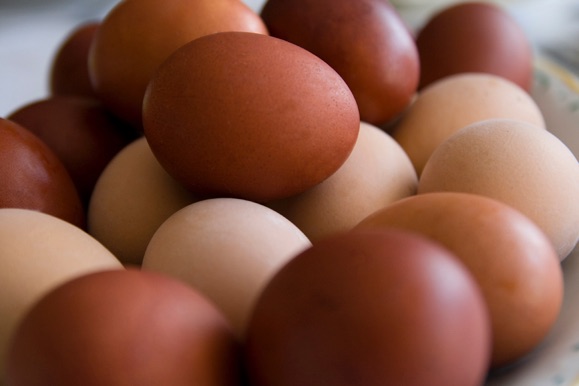Brown Eggs

Brown eggs are dyed in the same way that other eggs are, by acidifying the shell in a vinegar rinse initially, and then immersing the egg into the dye. But there are several things you should keep in mind when working with brown eggs.
1. Shell color affects final dye color. Chicken eggs run the gamut of colors from white, off-white, light blue and light green to just about any shade of brown imaginable. Brown eggs, depending on the type of hen that lays them, can be taupe to a deep reddish brown.

You can’t expect two eggs of such different hues to come out looking the same from any given dye bath. Some colors work well with brown eggs, usually those in the yellow-orange-red spectrum. Others, like light blues and greens, don’t (unless you are a huge fan of camouflage). Black and dark blue give nice final colors on a brown egg. This page gives you some idea of what many of the dyes look like on a brown egg.
Choose your colors carefully, and prepare to be surprised and/or disappointed with the results. I like to stick to combinations that work well (red/black, for instance), and find true beauty in a simple two-color egg of brown eggshell and black or blue.
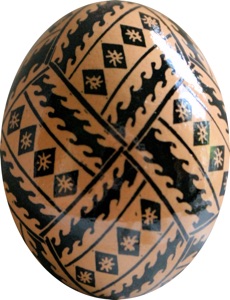
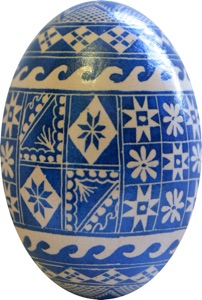
2. Brown eggs dye more slowly than white. The shell of a brown egg is usually thicker than a white one, and often “shinier” looking, too. I find that brown eggs often need much more time in the dye to get a good, deep color, 2 to 3 times as long as white eggs. It helps to really acidify the shell beforehand, leaving it in the vinegar rinse until lots of bubbles have formed on the shell surface.
-
3. Dyed brown eggs often have wax adhesion problems. While beeswax sticks well to a brown eggshell, no better or worse than it does to white one, it often falls off of a dyed brown eggshell, particularly a red one. This may be because it takes more dye to color a brown egg, and the surface is slicker, but I can’t say for sure. Dots and thin lines often fall off the egg while it is in the next dye bath. You can see that many lines have fallen off of this pysanka:
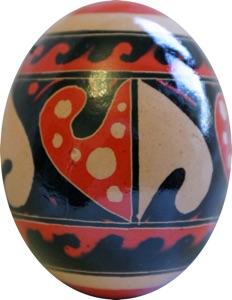
To avoid this problem, I plan my designs so that the colored areas (usually red) are not new, separate design elements like dots or drops or fringe or lines, but are colored in spaces between already placed lines. This pysanka shows how easily an nicely this problem can be avoided:
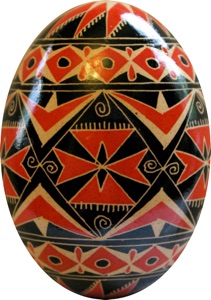
4. Brown eggs leak. This is not directly a dye issue, but I have found that brown eggs go bad much more quickly than white ones, even when refrigerated. I don’t know why this is--perhaps they are processed differently? Sometimes the egg contents will begin to extrude through the shell, either while the egg is just sitting, but especially when the egg is heated to remove wax. This makes a mess of the dyed shell.
I usually prefer to work on full eggs, but brown eggs are an exception. Unless you are working on very fresh eggs, empty them first.
Dyeing brown eggs



